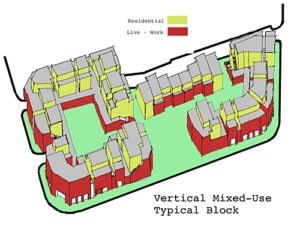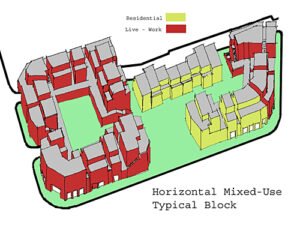Rapid growth in our city centers leads to the requirement of more space to carry out activities, more residences, offices, and shopping malls, etc. Lack of space leads planners to find creative solutions to it. As modern problems require modern solutions. A concept of mixed-use developments has come to place. Mixed-Use Developments sustainably utilize resources and space and also but also provides city inhabitants with neighborhoods that integrate work, home, shopping, transportation, and even green spaces.

Mixed-Use development can be a single building, an accumulation of several buildings, or even an entire neighborhood. Restaurants, boutiques and apartments bring a lot of life to a city corner while allowing people to live, work and play in the same space.
The Urban Land Institute’s Mixed-Use Development Handbook characterizes mixed-use development as one that
- provides three or more significant revenue-producing uses (such as retail/entertainment, office, residential, hotel, and/or civic/cultural/recreation),
- fosters integration, density, and compatibility of land uses,
- creates a walkable community with uninterrupted pedestrian connections.
As these developments are usually located in heart of the city, the residents and users live close by to their offices, schools or even shopping centers, reducing the need to drive. Which means less cars on the streets and more pedestrians or bicycle-friendly environments.
Vertical Mixed-Use Development
- Combines different uses within the same building
- Provides for more public uses on the lower floor such as retail shops, restaurants, of commercial businesses
- Provides for more private uses on the upper floors such as residential units, hotel rooms, or office space.
Horizontal Mixed-Use Development
- Consists of single-use buildings within a mixed-use zoning district parcel, which allows for a range of land uses in a single development project
- Provides for a variety of complementary and integrated uses that are walkable and within a given neighborhood, tract or land, or development project
Mixed-Use Walkable Areas
- Combines both vertical and horizontal mix of uses in an area, within an approximately 10-minute walking distance to core activities



Challenges in mixed-use developments
- Security Issues: In every development when you have multiple uses for a building, there will be areas restricted for one group and open for another. Regulating the access of private areas from the public areas is necessary. For example: shoppers shouldn’t be laundering in the hallways of residential apartments. While designing, separated access to separate functions should be ensured.
- Noise Transfer: As residences are close to the public areas, noise is easily transferred disturbing the residents. Even though residents understand their surroundings are such noisy places but, continues disturbance in residence can create uncomfortable atmosphere within. Planning strategies or materials should be wisely chosen to overcome this problem. Like noise insulating walls and flooring materials should be used.
- Trash and Foul Smell: – Retail areas and restaurants can produce a lot of garbage and obnoxious smells. Improper dumping facilities can cause foul smell floating into residences and troubling the users. Congesting and tight dumps should be avoided rather open space for the smell to dissipate should be allocated.
- Parking: As there is a variety of users in the developments, some from within and some from other areas, there is need for a parking space. Thought must be given to the various uses and when each space will be active to plan for the correct number of parking spaces for the overall development.
- Maintenance: Due to a variety of users, there is a large number of people using the same area for different purposes. Scheduling maintenance is a challenge as the building is occupied and accessible for various reasons at all times of the day. When repairs need to be done, trying to work out the logistics of access, particularly if it’s for a system that spans multiple tenancies, coordination among all the users can be a challenge.
Despite the challenges faced by landlords, residents, and management, mixed use developments bring energy to the streets day and night. Bringing people closer to where they work reduces the number of cars on the streets and saves a large amount of energy and time.

